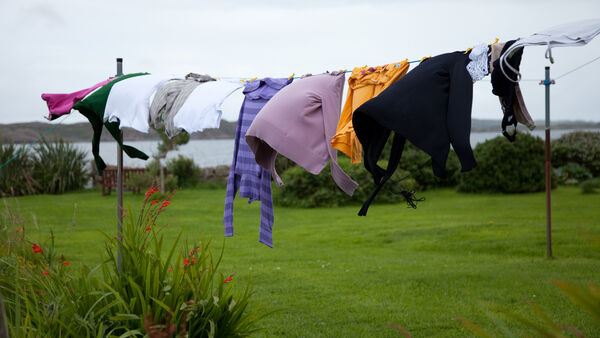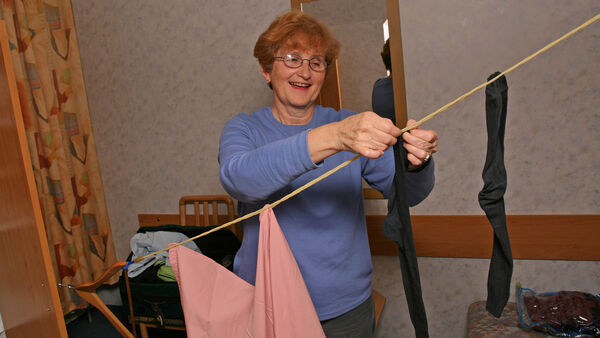Doing Laundry in Europe



By Rick Steves
I met a traveler in Italy who wore her T-shirt frontward, backward, inside-out frontward, and inside-out backward, all to delay the laundry day. A guy in Germany showed me his take-it-into-the-tub-with-you-and-make-waves method of washing his jeans. But you don't need to go to these extremes to have something presentable to wear. Find a launderette, splurge on full-service laundry — or do it yourself in your hotel room.
Using a Launderette
For a thorough washing, ask your hotel to direct you to the nearest launderette. In Western Europe, nearly every neighborhood has one; east of Germany, launderettes are less common. It takes about an hour and $10–15 to wash and dry an average-size load. (Some short-term rentals have laundry facilities, and many hostels have coin-op washers and dryers or heated drying rooms.)
Better launderettes have coin-op soap dispensers, change machines, English instructions, and helpful attendants. Others are completely automated — but many of these have pictogram instructions that usually aren't too hard to parse. Look around for a sign listing the "last wash" time, and stick to it. When it's closing time, an attendant might come by to evict you, or the machines may simply stop operating.
While the exact procedure varies, it usually includes the same steps as you'd encounter at a launderette at home. If you're planning on visiting a launderette, you could pack one or two small detergent boxes, although you can typically buy some at the launderette from a dispenser. The soap compartments on most washers have three reservoirs: for prewash, the main wash cycle (normally at the top of the washer), and fabric softener. (Don't put your main soap into the prewash compartment, or it'll be washed away before its time.)
While you might be able to pay at the washer itself, more likely you'll have to insert your money at a central unit. Note the number of your machine, then type that number into the central unit and put in your coins (use exact change if possible — some machines don't give change). Sometimes a central unit dispenses tokens, which you then insert in the machine.
Select your cycle, either at the machine itself or at the central unit. Below I've listed some of the cycles you're likely to see. The first number is the temperature in Celsius for the first cycle (prewash), the second is the temperature for the second cycle (main wash), and the third is how long the whole process takes:
45° / 90° / 55 m whites (very hot)
45° / 60° / 50 m colors (hot)
45° / 45° / 40 m permanent press (warm)
— / 30° / 30 m nylon (lukewarm)
— / 20° / 25 m delicates (cold)
Some washing machines have a built-in spin cycle, while others leave clothes totally soaked. In this case, you'll need to put your wet clothes in a special spin-dry machine (usually called a "centrifuge" or something similar) to wring out excess water before moving them to the dryer.
Some European clothes dryers are not vented to the outside, but instead collect the water from the clothes in an interior reservoir. The dryer will stop and an icon will light up when this reservoir is full and needs to be emptied. Ask an attendant if you can't figure out how.
Drying time is generally available in smaller units (5- or 10-minute increments) rather than as a full cycle. Most machines let you choose the drying temperature: low (cool and slow); medium (warmer but still slow); and high (speedy but shrinky). Because both washers and dryers at launderettes can be unpredictable, hand wash anything that you value dearly.
While waiting for your clothes, use the time to picnic, catch up on postcards and your journal, or chat with other customers. Launderettes throughout the world seem to give people the gift of gab. Many launderettes have Wi-Fi. If you ask attendants sweetly, they might be willing to transfer your clothes to the dryer, allowing you to slip out for some bonus sightseeing. (In these cases, it's appropriate to thank them by offering a small tip.)
Hiring It Out: Some launderettes offer full service, which means they'll wash, fold, and sometimes even iron your laundry. Just drop it off and come back later in the day. This service is more expensive than doing it yourself — you'll generally be charged by the kilo or by the item — but can save lots of time. Also pricey, but handiest of all: You can pay your hotel to do your laundry. Regardless of the cost, every time I slip into a fresh pair of pants, I figure it was worth the hassle and expense.
Washing Clothes in Your Room
One of my domestic chores while on the road is washing my laundry in the hotel-room sink. The budget-minded may choose to do all of their laundry this way; others just wash socks and underwear between trips to the launderette.
I keep it very simple, using hotel laundry bags to store my dirty duds, washing my clothes with hotel shampoo, and improvising places to hang things. But you can pack a self-service laundry kit: a plastic or mesh bag with a drawstring for dirty clothes, concentrated liquid detergent (either in individual travel packs or a small, sturdy, plastic squeeze bottle wrapped in a sealable baggie to contain leakage), and a stretchable travel clothesline (a double-stranded cord that's twisted, so clothespins are unnecessary).
To make things easier, I bring a quick-dry travel wardrobe that either looks OK wrinkled or doesn't wrinkle. (I test-wash my shirts in the sink at home before I let them come to Europe with me. Some shirts dry fine; others prune up.)
Most European hotels prefer that you not do laundry in your room. Some bathrooms even have a multilingual "no washing clothes in the room" sign (which, after "eat your peas," may be the most ignored rule on earth). Interpret hoteliers' reticence as "I have lots of good furniture and fine floors in this room, and I don't want your drippy laundry ruining things." As long as you wash carefully and are respectful of the room, go right ahead.
Sometimes a hotel will remove the sink and tub stoppers in an attempt to discourage washing. Bring a universal drain stopper from home, try using a wadded-up sock or a pill-bottle lid, or line the sink with a plastic bag and wash in it. Some travelers create their own washing machine with a large, two-gallon sealable baggie: soak in suds for an hour, agitate, drain, rinse.
Wring wet laundry as dry as possible to minimize dripping. Other than a clogged toilet, there's little a hotelier likes seeing less than a pool of water on their hardwood floors. Rolling laundry in a towel and twisting or stomping on it works well (if you have an extra towel — remember that many accommodations don't provide new towels every day).
Account for drying time: Cotton needs much longer to dry than the lightweight performance fabrics often used in travel clothing. Hang clothes in a low-profile, nondestructive way. Suspend them over the bathtub or in a closet. Housekeeping hardly notices my laundry, as it's either hanging quietly in the bathroom or shuffled among my dry clothes in the closet. Separate the back and front of hanging clothes to speed drying time. (Some travelers pack inflatable hangers for this.) Don't hang your clothes out the window or on the balcony — hoteliers find it unsightly, and you might find it has blown away when you return from dinner. Laid-back hotels will let your laundry join theirs on the lines out back or on the rooftop.
Smooth out your wet clothes, button shirts, set collars, and "hand iron" to encourage wrinkle-free drying. If your shirt or dress dries wrinkled, hang it in a steamy bathroom or borrow an iron and ironing board from the hotel (nearly all have loaners). A piece of tape is a good ad hoc lint brush. In very hot climates, I wash my shirt several times a day, wring it, and put it on damp. It's clean and refreshing, and (sadly) in 15 minutes it's dry.

